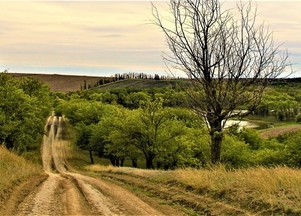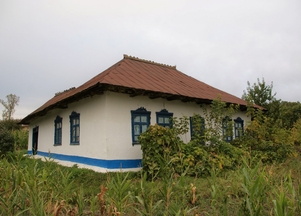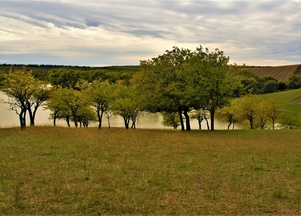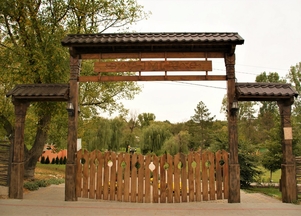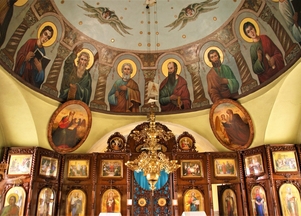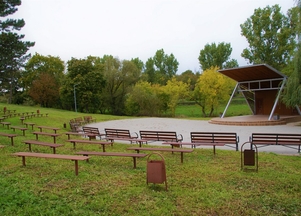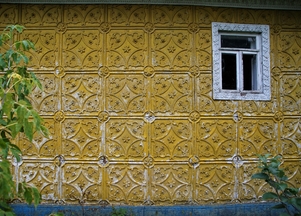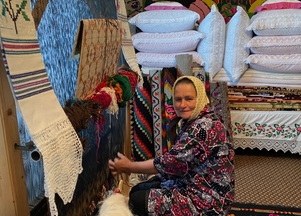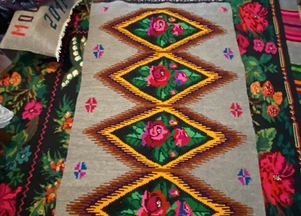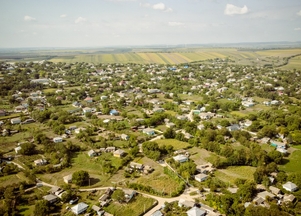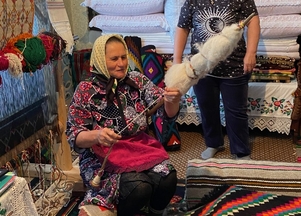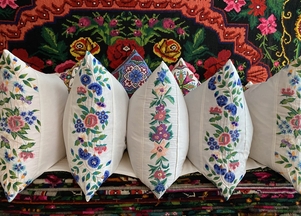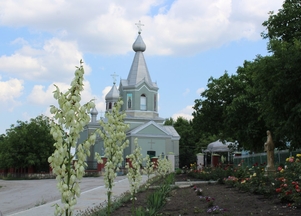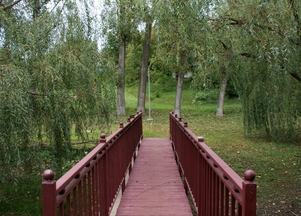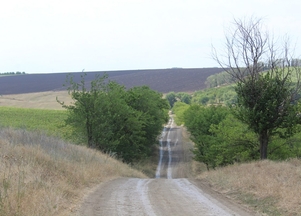Mihăileni
History
The village of Mihăileni is situated on two rather steep hills along the bed of the Ochiul-Alb (White Eye) river. The perimeter of the village estate stretches over a distance of 39 km 388 m, comprising a total area of 6091 ha of farmland, pastures, fallow land, which are not used for agricultural purposes. On the village estate there are also artificial lakes with rather large water mirrors. It shares borders with the villages of Știubeieni, Ciubara, Baraboi, Ochiul-Alb, Ramazan, Rîșcani and Vasileuți. Stone objects have been discovered in these places, which gives us grounds to say that people have lived here since the Stone Age.
Statues of the goddess of Fertility and Femininity have also been discovered in the village of Mihaileni, which indicates the period of the Cucuteni-Tripolian archaeological culture.
To put it in simpler language, this means a time span of over 5000 years BC, or 7000 to the present day. A similar statuette of this goddess is kept in a prestigious museum in Iași, discovered in the Cucuteni locality in Iași county. The Cucuteni-Tripolian culture is characterized by ceramic objects painted with geometric motifs, anthropo- and zoo- morphic clay figurines, some of stone and bone.
The oldest known settlements in the village of Mihaileni were six, but the most historically interesting ones are at Rusca and the Curcovo estate.
Following the historical chronology of these settlements, we can deduce that they came into being at the end of the 17th century. Legends and stories about the establishment and disappearance of these settlements have been handed down from father to son.
At Rusca, accidentally, without organized archaeological research for scientific purposes, vestiges were discovered, which testify to the ancient human settlement: burnt brick, shards of clay pots, bones, etc.
Another settlement of historical interest is the Curcovo Monastery. Unfortunately, none of the monastery buildings have survived.
According to the oldest information on the establishment of the village of Mihăileni, the first inhabitant of this settlement was Ion Samson, who came from the area of Gălășeni. From there, he took his herds of several hundred sheep and settled with his entire family on the estate of the village of Mihăileni, which belonged at that time to the Moldavian ruler Ion Sturza. To this day, one of the village's slums bears the name "Gălășeni neighbourhood".
Their descendants also bore the following surnames: Gălălășanu, Samson, Scutaru. Later on, the inhabitants of the Rîșcani area settled here in this hamlet. Later on there was the "Brânzeni neighbourhood" - with inhabitants coming from the village of Mărculesti, the "Mustețenilor neighbourhood" - with inhabitants from the villages of Musteața, Scăieni, Ghizdita as well as from Ciubara, the "Zăicăni neighbourhood" - with inhabitants from the villages of Zăicani and Șaptebani.
Referring again to the historical sources on the founding of the village - it dates back to December 12, 1646 - a document that puts us in the theme that at that time, "inhabitants of the village of Mihaileni participated in a trial in Iași because of the boundaries of the estates.
''As a now-settled locality we are also reminded of another authentic document. It is the ''Ghica Voda's Census'', in which the village of Mihăileni appears under another, earlier name - Sălcieni, which is approximately Mihăileni.
From that census document we also learn that 92 households were registered in the village, and 12 households belonged to legionaries from the mountains, coming from the village of Burdujeni, Suceava county (today Mihăileni, Botoșani county).
From across the Prut originate families like you can still find today in Mihăileni - Ursu, Eșanu, Ciocanu, Lupașcu.
In 1837, now that Bessarabia had been annexed to Tsarist Russia according to the Peace of Bucharest, the administrative organization of the estate of the village of Mihaileni was made, establishing its boundaries.
A couple of decades later, Squire Leondar took a more qualified census. At that time it was established that Mihăileni had 187 households and 1333 inhabitants. After 9 years in 1870, a second census was taken and it was established that the number of households had almost doubled - there were already 350, but it is not known why the number of inhabitants had increased considerably, as at that time 2261 inhabitants were registered.
And there has also been a decrease in population numbers. In the 1910 census 637 households were registered in the village, in the 1923 census - 781 households, in 1910 there were 2663 inhabitants, and in 1923 the number had decreased - there were 2616 inhabitants.
Another significant page in the history of the village is also the year 1870, when the Russian scientist Vasile Docuceaev, a renowned pedagogue, while researching the lands that were within the parameters of the Mihaileni estate, came to the conclusion that the soils of Moldavia were the most fertile he had ever known.
The first scholar with higher education was Tudor Musteață. He was a member of the Russian State Duma, and participated in the events of 1917. According to documents, the first mayor of the village was Simion Spataru.
The Church of the Mother of God in the village of Mihaileni was designed in 1876 by the deputy governor Piche and the architect R. Savițchi. The church is built in the shape of a cross: length - 29 meters; height - 22 meters, with tin roof, two metal crosses. The construction was administered by the Protopriest Ioan Pavel Barbu, the Malakian priest Nichifor Savițchi. In 1883 the church was consecrated and began its work. In 1900 it was in the Bălți county, Chisinau diocese. On April 3rd 1964 the church was closed. In 1986 a museum was opened inside the church. In 1988 the church "The protection of the Mother of God" in the village of Mihăileni was reopened.
Beautiful places
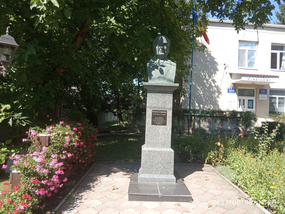
Bust of Eugen Coșeriu
Eugen Coșeriu (or Eugenio Coseriu, born in 27 July 1921 , commune Mihăileni , county of Balti , - deceased 7 September 2002 , Tübingen , Germany). Romanian linguist in exile honorary member of the Romanian Academy (from 1991 ).
Read more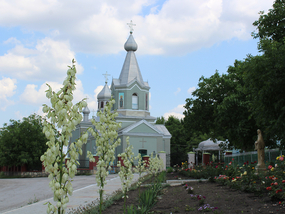
Church Mihăileni
The Church of the Mother of God was designed in 1876 by Deputy Governor Piche and architect R. Savitchi. The church is built in the shape of a cross: length - 29 meters; height - 22 meters, with tin roof, two metal crosses.
Read moreFigures
Eugeniu Coșeriu (or Eugenio Coseriu, b. 27 July 1921 - d. 7 September 2002 , Tübingen , Germany ) was a Romanian linguist in exile, honorary member of the Romanian Academy (from 1991). He is the founder of the first linguistic school in South America and Tübingen . The father of what is today called integral linguistics, Eugeniu Coșeriu is one of the most important linguists of the 20th century.
Graduated "Ion Creanga" high school in the town of Balti , then continued his studies in philology at the universities of Iași and Rome; he also studied philosophy at the University of Milan . Between 1950 and 1963 taught at the University of Montevideo , Uruguay between 1961 and 1963 he was also visiting professor at the University of Bonn , Germany . From 1963 and until the end of his life he was professor at Tübingen . Several generations of Eugen Coșeriu's disciples constitute Tübingen School of Linguistics . He was Doctor Honoris Causa of almost 50 universities worldwide.
PhD in Philology and Philosophy, author of more than 50 volumes and thousands of pages of exegesis, of new theories on the fundamental principles of philology, contributes to the enrichment of the methodology of linguistic disciplines.
Valentin Mândâcanu (b. 27 July 1930 - d. 29 October 2012) was a philologist, linguist, translator and publicist from the Republic of Moldova , Member of Parliament in Parliament of the Republic of Moldova between 1990-1994. He is one of the 278 signatories of the Declaration of Independence of the Republic of Moldova .
He completed three classes at High School "Ion Creanga" in Balti, after which, in 1944, he fled with his parents across the Prut to Craiova . After graduating from the Pedagogical Institute in Chisinau he became a teacher at Pedagogical School of Calarasi . In 1966 he was hired as editor and stylist at the magazine "Moldova".
He made his publishing debut with the volume "Correct Expression" (1967) and later worked as a translator for the Telegraphic Agency of Moldova (ATEM), then as a contributor to the "Moldovan Soviet Encyclopedia" (1979), from where he was dismissed, accused of "Romanianizing" the language.
His volume "The Right Word in the Right Place" (1979, 1987) proved extremely timely in the work of promoting and cultivating the Romanian language in Bessarabia. He also edited the books "Between home and home" (2000) and "Breaks in the ice of silence" (2008).
Valentin Mândâcanu is known, above all, as a fierce fighter for the Romanian language and the return to the Latin alphabet. In 1988, he published the essay-manifesto "The dress of our essence" in issue 4 of "Nistru" magazine, which had a wide resonance and triggered a real social movement for the return to Latin spelling.
In 1996 he was awarded the "Civic Merit" Medal. In 2009 he became an honorary citizen of Chisinau . In 2010 Valentin Mândâcanu was decorated with the " Order of the Republic ".
Raisa Lungu-Ploaie (b. 15 August 1928) is a writer. She is the daughter of Maria and Ion Ploaie. She graduated from the Maxim Gorky Institute of Literature in Moscow (1964). She was a teacher at a school of general culture, editor of the magazines "Nistru" and "Women of Moldova".
The volumes "Stories" (1960), "Song of a violin" (1962), "Mărţişoare" (1964), "Blue feather" (1972) and "Ehite horizons" (1974) stand out for the finesse of their psychological analysis and their sobriety. They set a special moment in women's prose because of their dramatic texts, in which the characters "collapse into the gaps between the Bovary-an illusion of life and its vital situations" (Mihai Cimpoi).
The novel The Love of a Lifetime (1982) evokes moments in the dedicated and sacrificial lives of doctors. She has translated from Daniel Defoe ("Robinson Crusoe"), Konstantin Paustovski ("The Golden Rose"), Cinghiz Aitmatov ("Farewell, Gulsar"), etc.
Gheorghe Dodiță (b. 12.04.1931 - d. 09.08.2012) Distinguished professor, prolific researcher and a notorious personality in our culture, Gheorghe Dodiță held for almost six decades the university course "Ancient Romanian Literature" in front of the students of the faculties of Letters, History and Journalism. The perpetual investigation of scientific sources, the painstaking research of ancient texts provided Gheorghe Dodiță with the substance of the textbook "Ancient Romanian Literature".
Margareta Cemârtan (b. 19 November 1942). In 1949 she was deported to Siberia and returned to her native village in 1956.
In 2002 she published three essays "The Apple", "Mustangs and Wolves", and in 2006 "Wolves" (Childhood Memories).
Grigore Vieru: "Margareta Cemârtan-Spânu is one of the victims of the criminal Stalinist regime. And her tragic fate is the image of the drama of the whole Bessarabia. We find in "Childhood Memories" the opposite face of the luminous childhood described by Creanga, disturbing pages that only a soul whose beauty and purity were deeply wounded in childhood and adolescence could put on paper".
Margareta Cemârtan-Spânu was deported on July 7, 1949, as part of the secret IUG (SOUTH) operation carried out by the Soviet authorities. Because she had no mother, she was deported together with her grandmother, father and brother. At the time she was 6 and a half years old. Her harsh memories of the deportations were described in her book "The Wolves", published in Chisinau in 2006. "Love of Doves", published in autumn 2008 (Reclama Publishing House), is a book about the years after the deportations with her husband and children.
Mircea Gutu (b. May 1963 - d. March 2013) is the son of Elena and Vasile Gutu. Performer and composer. Founder of the band "Colinda". Worked in showbizz for more than two decades. He wrote songs for performers such as Olga Ciolacu and the Corduneanu brothers. Most of Moldovan artists recorded songs in his studio.
Video presentation
In the following video presentation, you will be invited to discover the beauty of the banks of the Prut River in the Republic of Moldova. This picturesque area is known for its idyllic landscapes, where the river Prut flows quietly through the hills
Events


 ro
ro
 ru
ru

